tow TOYOTA MATRIX 2010 E140 / 2.G Owners Manual
[x] Cancel search | Manufacturer: TOYOTA, Model Year: 2010, Model line: MATRIX, Model: TOYOTA MATRIX 2010 E140 / 2.GPages: 448, PDF Size: 9.74 MB
Page 1 of 448
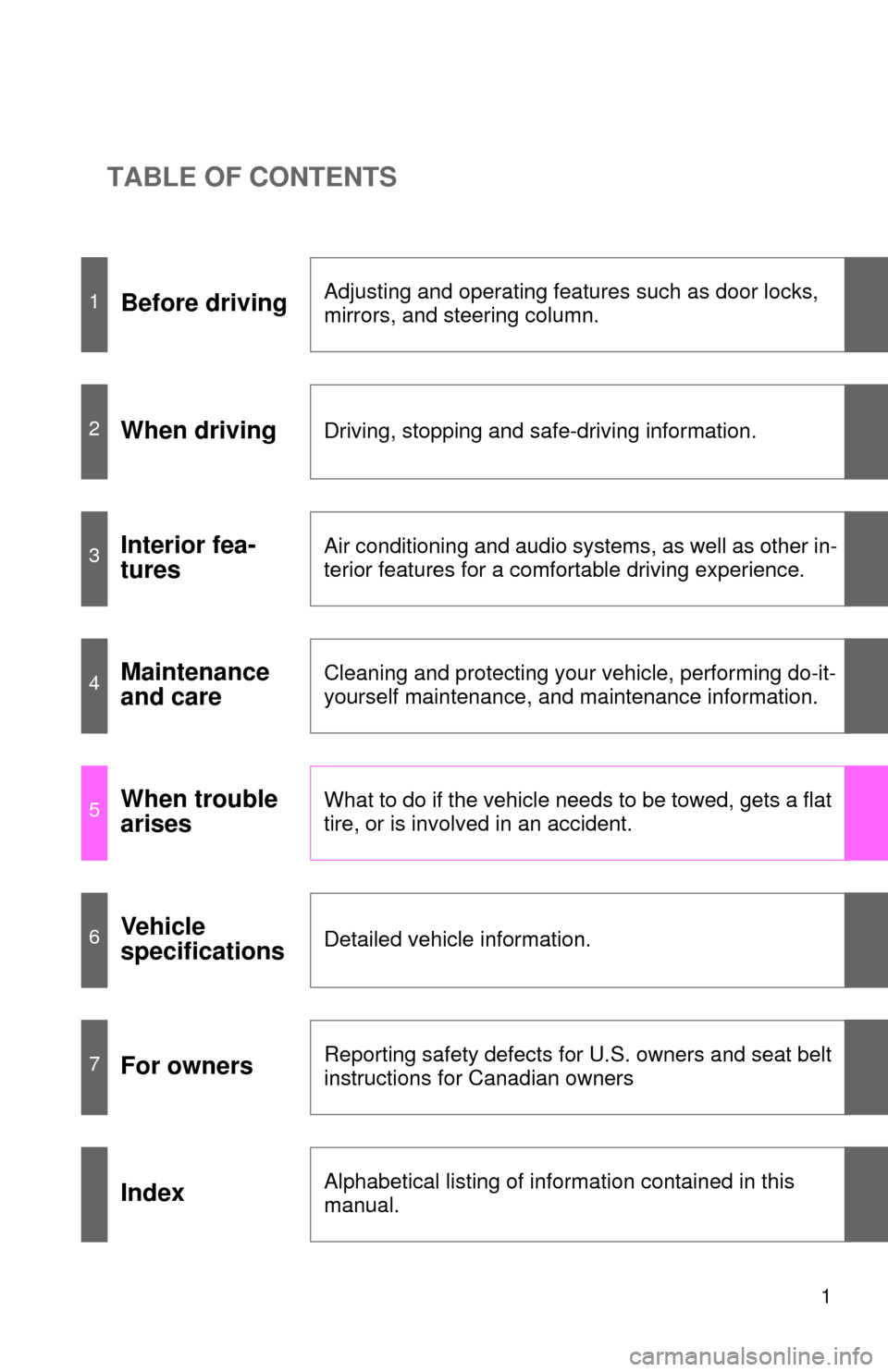
TABLE OF CONTENTS
1
1Before drivingAdjusting and operating features such as door locks,
mirrors, and steering column.
2When drivingDriving, stopping and safe-driving information.
3Interior fea-
turesAir conditioning and audio systems, as well as other in-
terior features for a comfortable driving experience.
4Maintenance
and careCleaning and protecting your vehicle, performing do-it-
yourself maintenance, and maintenance information.
5When trouble
arisesWhat to do if the vehicle needs to be towed, gets a flat
tire, or is involved in an accident.
6Vehicle
specificationsDetailed vehicle information.
7For ownersReporting safety defects for U.S. owners and seat belt
instructions for Canadian owners
IndexAlphabetical listing of information contained in this
manual.
Page 3 of 448

1
2
3
4
5
6
7
3
2-5. Driving information
Cargo and luggage ............. 147
Vehicle load limits ............... 150
Winter driving tips ............... 151
Trailer towing ...................... 155
Dinghy towing
(automatic
transmission) .................... 163
Dinghy towing
(manual transmission) ...... 164
3-1. Using the air conditioning
system and defogger
Air conditioning system ....... 168
Rear window and
outside rear view
mirror defoggers ............... 174
3-2. Using the audio system
Audio system types ............. 175
Using the radio .................... 178
Using the CD player ............ 184
Playing MP3 and WMA
discs.................................. 191
Optimal use of the audio
system .............................. 199
Using the AUX adapter ....... 202
Using the steering wheel
audio switches .................. 203
3-3. Using the hands-free phone
system (for cellular phone)
Hands-free phone system
(for cellular phone)
features ............................. 206Using the hands-free
phone system
(for cellular phone) ........... 209
Making a phone call ........... 218
Setting a cellular phone ...... 222
Security and system
setup ................................ 227
Using the phone book ........ 231
3-4. Using the interior lights
Interior lights list ................. 238
• Interior light ...................... 239
• Personal/interior lights...... 240
• Personal lights.................. 241
3-5. Using the storage features
List of storage features ....... 242
• Glove box ......................... 243
• Console box ..................... 243
• Cup holders ...................... 245
• Bottle holders ................... 247
• Auxiliary boxes ................. 248
3-6. Other interior features
Sun visors........................... 250
Vanity mirrors ..................... 251
Clock .................................. 252
Ashtrays ............................. 253
Cigarette lighter .................. 254
Power outlet ....................... 255
Grocery bag hook ............... 257
Seatback table.................... 259
Floor mat ............................ 260
Luggage compartment
feature .............................. 261
Compass ............................ 268
3Interior features
Page 4 of 448

TABLE OF CONTENTSIndex
4
4-1. Maintenance and care
Cleaning and protecting
the vehicle exterior ........... 274
Cleaning and protecting
the vehicle interior ............ 276
4-2. Maintenance
Maintenance
requirements .................... 279
General maintenance ......... 281
Emission inspection and
maintenance (I/M)
programs .......................... 284
4-3. Do-it-yourself maintenance
Do-it-yourself service
precautions ...................... 285
Hood................................... 289
Positioning a floor jack ....... 291
Engine compartment .......... 294
Tires ................................... 308
Tire inflation pressure......... 317
Wheels ............................... 321
Air conditioning filter ........... 323
Key battery ......................... 325
Checking and replacing
fuses ................................ 328
Light bulbs .......................... 3375-1. Essential information
Emergency flashers ............ 348
If your vehicle needs to
be towed ........................... 349
If you think something
is wrong ............................ 355
Fuel pump shut off
system .............................. 356
Event data recorder ............ 357
5-2. Steps to take in an
emergency
If a warning light turns on
or a warning buzzer
sounds... .......................... 359
If you have a flat tire ........... 369
If the engine will not start .... 383
If the shift lever cannot be
shifted from P ................... 384
If you lose your keys ........... 385
If the battery is
discharged ........................ 386
If your vehicle overheats..... 391
If the vehicle becomes
stuck ................................. 394
4Maintenance and care5When trouble arises
Page 27 of 448

27 1-2. Opening, closing and locking the doors
1
Before driving
■Key battery depletion
If the wireless remote control function does not operate, the battery may be
depleted. Replace the battery when necessary. (P. 325)
■Security feature
If a door is not opened within approximately 60 seconds after the vehicle is
unlocked, the security feature automatically locks the vehicle again.
■Conditions affecting operation
The wireless remote control function may not operate normally in the follow-
ing situations.
●Near a TV tower, radio station, electric power plant, airport or other facil-
ity that generates strong radio waves
●When carrying a portable radio, cellular phone or other wireless commu-
nication devices
●When multiple wireless keys are in the vicinity
●When the wireless key has come into contact with, or is covered by, a
metallic object
●When a wireless key (that emits radio waves) is being used nearby
●When the wireless key has been left near an electrical appliance such as
a personal computer
●When the wireless key battery is depleted
●If window tint with a metallic content or metallic objects are attached to
the rear window
■Customization that can be configured at Toyota dealer
Settings (e.g. operation signal) can be changed.
(Customizable features P. 427)
Page 41 of 448
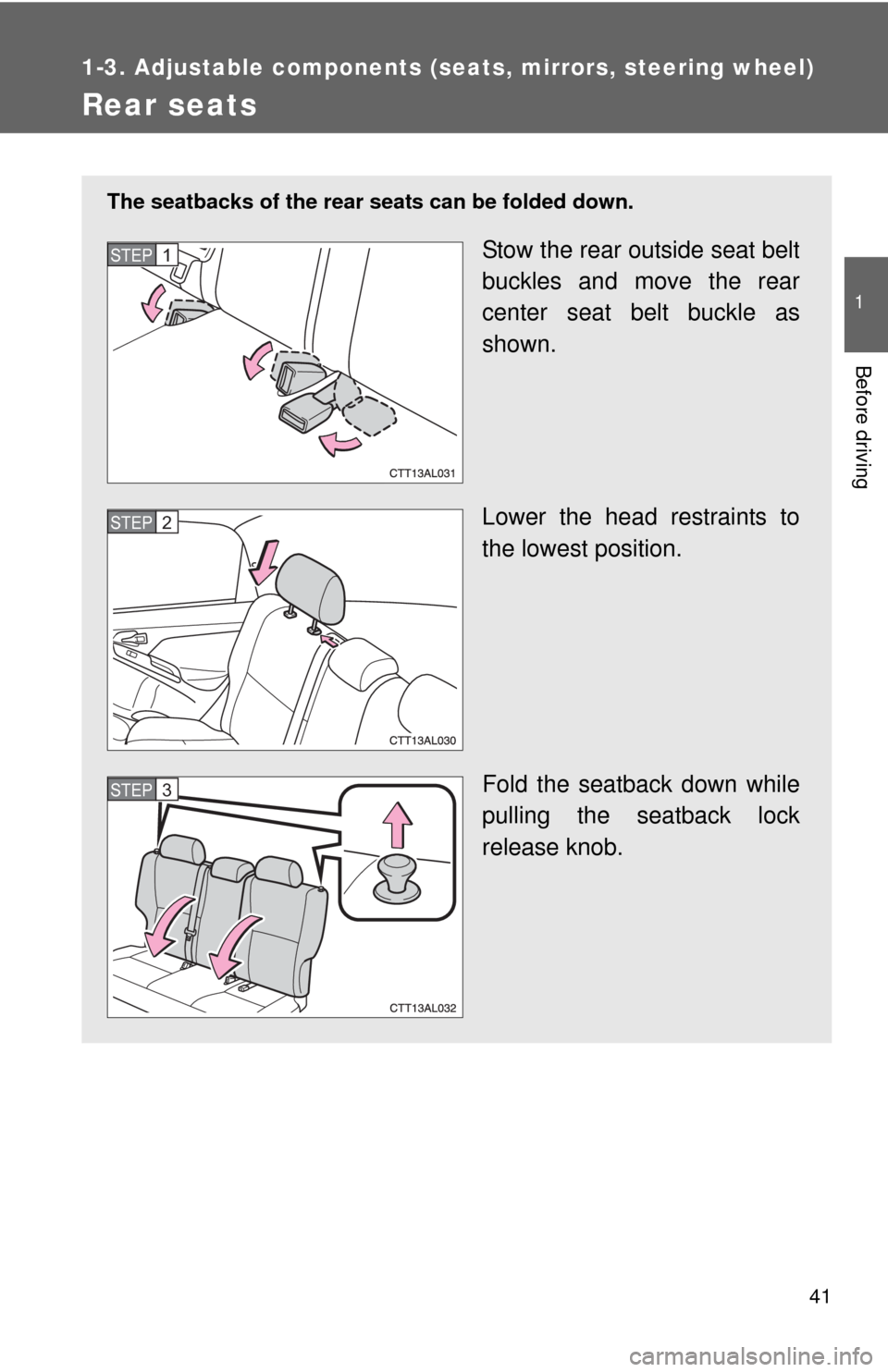
41
1
1-3. Adjustable components (seats, mirrors, steering wheel)
Before driving
Rear seats
The seatbacks of the rear seats can be folded down.
Stow the rear outside seat belt
buckles and move the rear
center seat belt buckle as
shown.
Lower the head restraints to
the lowest position.
Fold the seatback down while
pulling the seatback lock
release knob.STEP1
STEP2
STEP3
Page 44 of 448
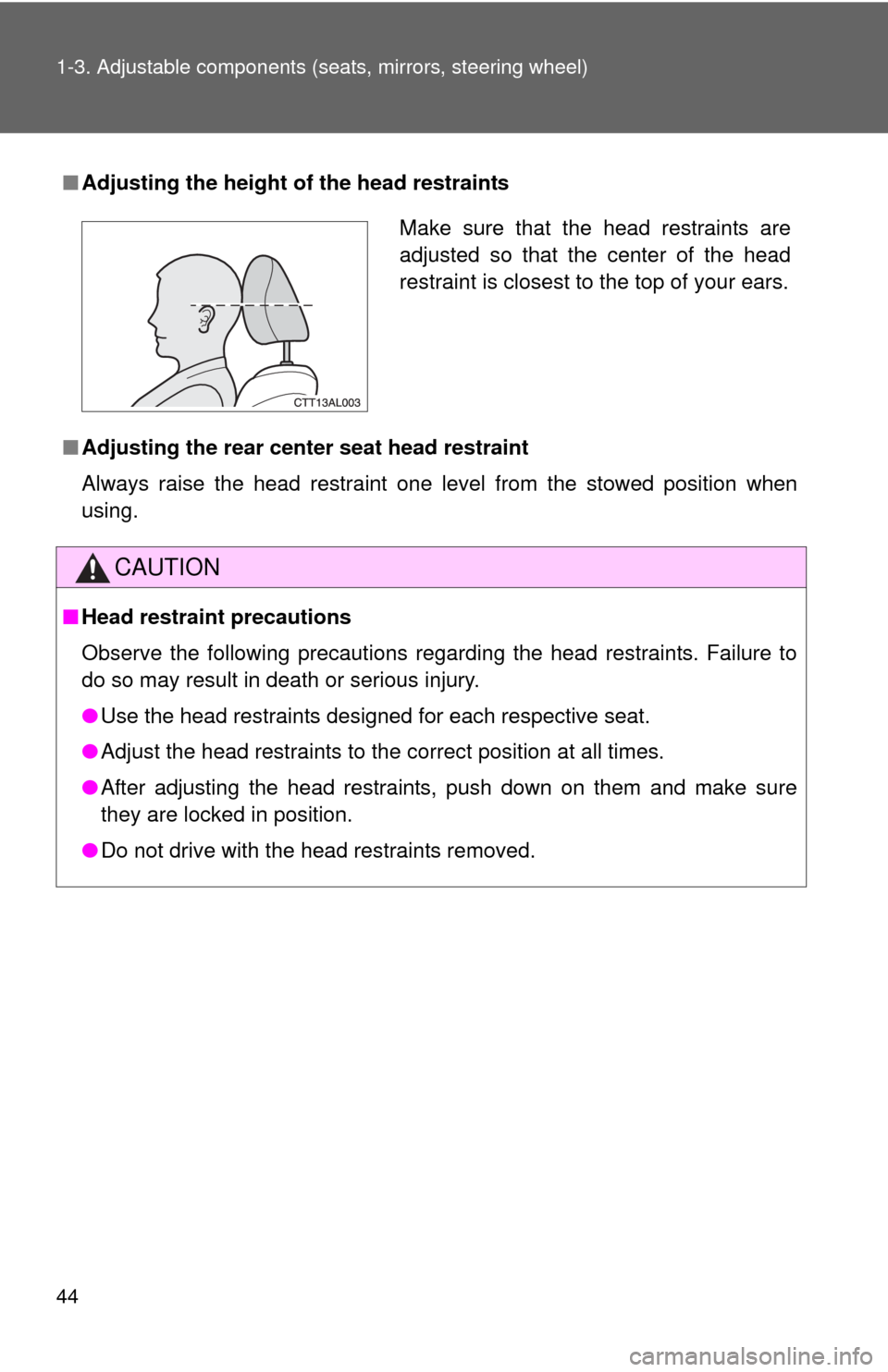
44 1-3. Adjustable components (seats, mirrors, steering wheel)
■Adjusting the height of the head restraints
■Adjusting the rear center seat head restraint
Always raise the head restraint one level from the stowed position when
using.
CAUTION
■Head restraint precautions
Observe the following precautions regarding the head restraints. Failure to
do so may result in death or serious injury.
●Use the head restraints designed for each respective seat.
●Adjust the head restraints to the correct position at all times.
●After adjusting the head restraints, push down on them and make sure
they are locked in position.
●Do not drive with the head restraints removed.
Make sure that the head restraints are
adjusted so that the center of the head
restraint is closest to the top of your ears.
Page 49 of 448
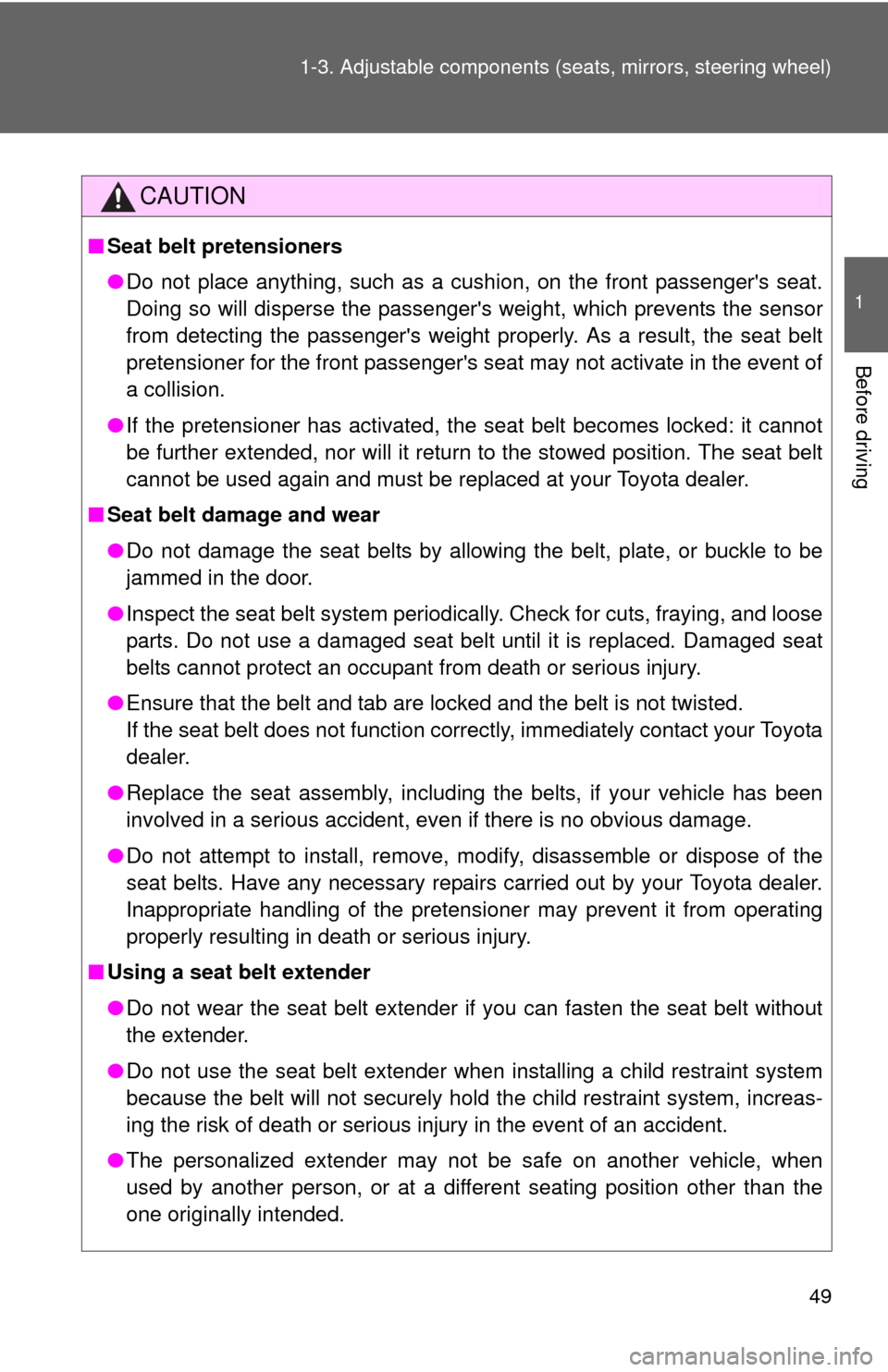
49 1-3. Adjustable components (seats, mirrors, steering wheel)
1
Before driving
CAUTION
■Seat belt pretensioners
●Do not place anything, such as a cushion, on the front passenger's seat.
Doing so will disperse the passenger's weight, which prevents the sensor
from detecting the passenger's weight properly. As a result, the seat belt
pretensioner for the front passenger's seat may not activate in the event of
a collision.
●If the pretensioner has activated, the seat belt becomes locked: it cannot
be further extended, nor will it return to the stowed position. The seat belt
cannot be used again and must be replaced at your Toyota dealer.
■Seat belt damage and wear
●Do not damage the seat belts by allowing the belt, plate, or buckle to be
jammed in the door.
●Inspect the seat belt system periodically. Check for cuts, fraying, and loose
parts. Do not use a damaged seat belt until it is replaced. Damaged seat
belts cannot protect an occupant from death or serious injury.
●Ensure that the belt and tab are locked and the belt is not twisted.
If the seat belt does not function correctly, immediately contact your Toyota
dealer.
●Replace the seat assembly, including the belts, if your vehicle has been
involved in a serious accident, even if there is no obvious damage.
●Do not attempt to install, remove, modify, disassemble or dispose of the
seat belts. Have any necessary repairs carried out by your Toyota dealer.
Inappropriate handling of the pretensioner may prevent it from operating
properly resulting in death or serious injury.
■Using a seat belt extender
●Do not wear the seat belt extender if you can fasten the seat belt without
the extender.
●Do not use the seat belt extender when installing a child restraint system
because the belt will not securely hold the child restraint system, increas-
ing the risk of death or serious injury in the event of an accident.
●The personalized extender may not be safe on another vehicle, when
used by another person, or at a different seating position other than the
one originally intended.
Page 77 of 448

77 1-7. Safety information
1
Before driving
CAUTION
■SRS airbag precautions
Observe the following precautions regarding the airbags.
Failure to do so may cause death or serious injury.
●The driver and all passengers in the vehicle must wear their seat belts
properly.
The SRS airbags are supplemental devices to be used with the seat belts.
●The SRS driver airbag deploys with considerable force, and can cause
death or serious injury especially if the driver is very close to the airbag.
The National Highway Traffic Safety Administration (“NHTSA”) advises:
Since the risk zone for the driver’s airbag is the first 2 - 3 in. (50 - 75 mm)
of inflation, placing yourself 10 in. (250 mm) from your driver airbag pro-
vides you with a clear margin of safety. This distance is measured from the
center of the steering wheel to your breastbone. If you sit less than 10 in.
(250 mm) away now, you can change your driving position in several
ways:
• Move your seat to the rear as far as you can while still reaching the
pedals comfortably.
• Slightly recline the back of the seat.
Although vehicle designs vary, many drivers can achieve the 10 in.
(250 mm) distance, even with the driver seat all the way forward, sim-
ply by reclining the back of the seat somewhat. If reclining the back of
your seat makes it hard to see the road, raise yourself by using a firm,
non-slippery cushion, or raise the seat if your vehicle has that feature.
• If your steering wheel is adjustable, tilt it downward. This points the air-
bag toward your chest instead of your head and neck.
The seat should be adjusted as recommended by NHTSA above, while
still maintaining control of the foot pedals, steering wheel, and your view of
the instrument panel controls.
Page 79 of 448
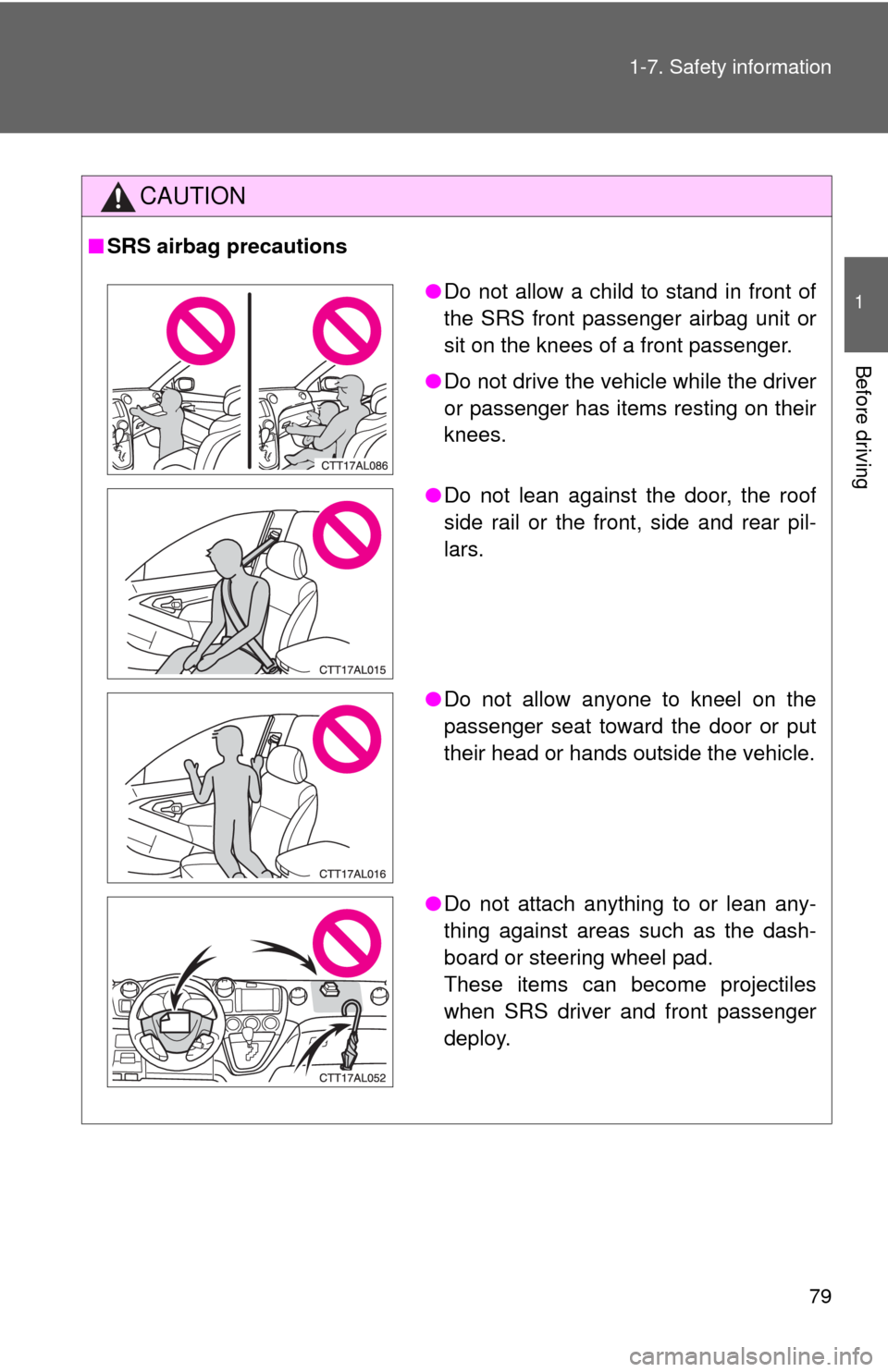
79 1-7. Safety information
1
Before driving
CAUTION
■SRS airbag precautions
●Do not allow a child to stand in front of
the SRS front passenger airbag unit or
sit on the knees of a front passenger.
●Do not drive the vehicle while the driver
or passenger has items resting on their
knees.
●Do not lean against the door, the roof
side rail or the front, side and rear pil-
lars.
●Do not allow anyone to kneel on the
passenger seat toward the door or put
their head or hands outside the vehicle.
●Do not attach anything to or lean any-
thing against areas such as the dash-
board or steering wheel pad.
These items can become projectiles
when SRS driver and front passenger
deploy.
Page 101 of 448
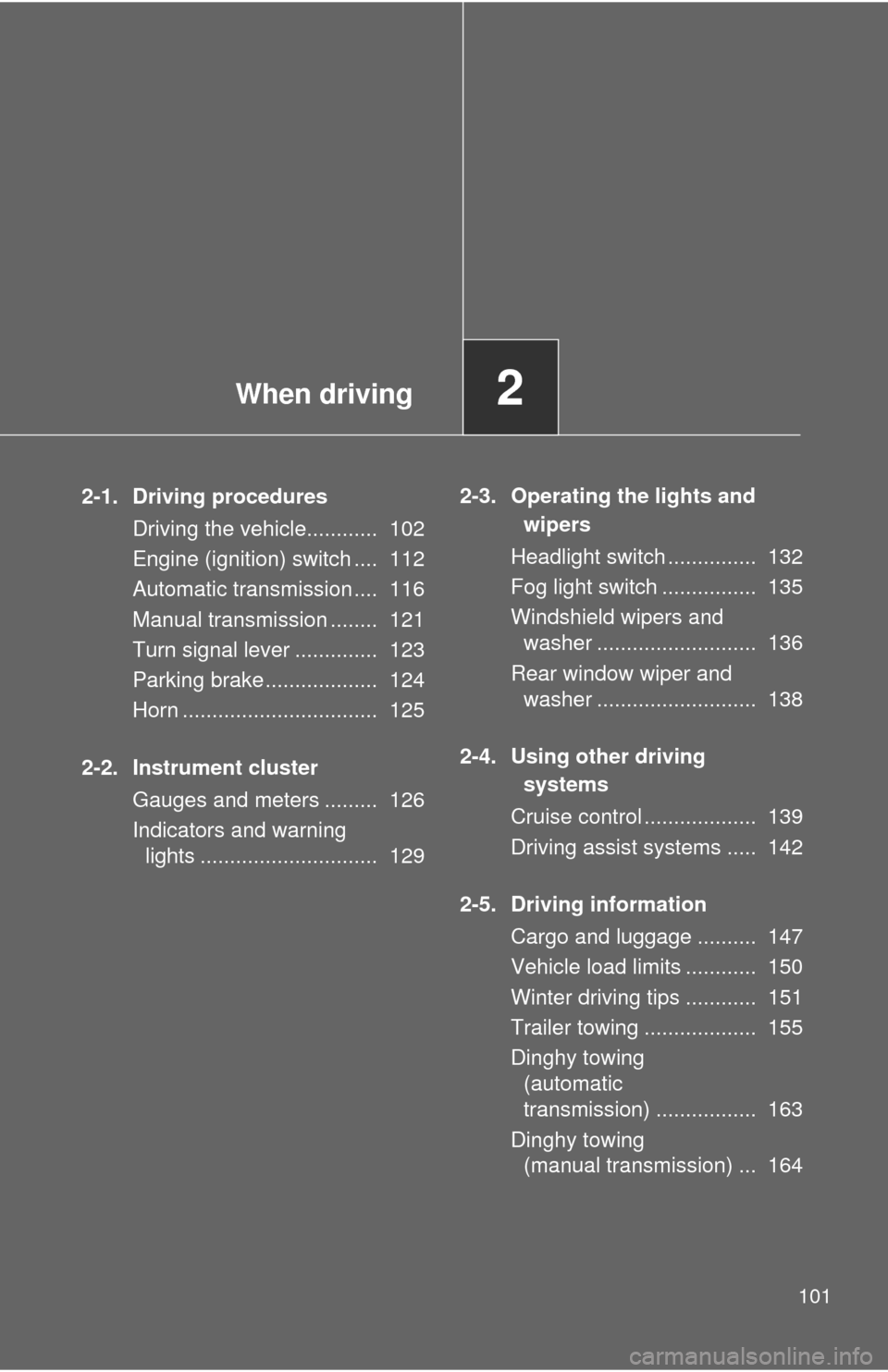
When driving2
101
2-1. Driving procedures
Driving the vehicle............ 102
Engine (ignition) switch .... 112
Automatic transmission .... 116
Manual transmission ........ 121
Turn signal lever .............. 123
Parking brake ................... 124
Horn ................................. 125
2-2. Instrument cluster
Gauges and meters ......... 126
Indicators and warning
lights .............................. 1292-3. Operating the lights and
wipers
Headlight switch ............... 132
Fog light switch ................ 135
Windshield wipers and
washer ........................... 136
Rear window wiper and
washer ........................... 138
2-4. Using other driving
systems
Cruise control ................... 139
Driving assist systems ..... 142
2-5. Driving information
Cargo and luggage .......... 147
Vehicle load limits ............ 150
Winter driving tips ............ 151
Trailer towing ................... 155
Dinghy towing
(automatic
transmission) ................. 163
Dinghy towing
(manual transmission) ... 164